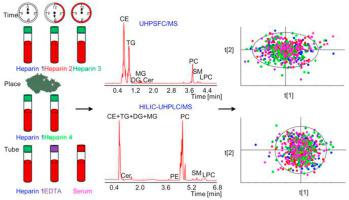当前位置:
X-MOL 学术
›
Anal. Chim. Acta
›
论文详情
Our official English website, www.x-mol.net, welcomes your feedback! (Note: you will need to create a separate account there.)
Determination of one year stability of lipid plasma profile and comparison of blood collection tubes using UHPSFC/MS and HILIC-UHPLC/MS
Analytica Chimica Acta ( IF 6.2 ) Pub Date : 2020-11-01 , DOI: 10.1016/j.aca.2020.08.061 Denise Wolrab , Michaela Chocholoušková , Robert Jirásko , Ondřej Peterka , Vladimíra Mužáková , Hana Študentová , Bohuslav Melichar , Michal Holčapek
Analytica Chimica Acta ( IF 6.2 ) Pub Date : 2020-11-01 , DOI: 10.1016/j.aca.2020.08.061 Denise Wolrab , Michaela Chocholoušková , Robert Jirásko , Ondřej Peterka , Vladimíra Mužáková , Hana Študentová , Bohuslav Melichar , Michal Holčapek

|
Effects of blood collection tubes, the time period, the sample origin, and the method used on the lipidomic profile are investigated by ultrahigh-performance supercritical fluid chromatography - mass spectrometry (UHPSFC/MS) and hydrophilic interaction liquid chromatography ultrahigh-performance liquid chromatography - mass spectrometry (HILIC-UHPLC/MS). Heparin plasma samples have been obtained from 99 healthy volunteers at three time points separated by six-month intervals together with one collection for EDTA plasma and serum. Furthermore, lipid concentrations in heparin plasma collected at two different sites are compared. 171 lipid species from eight lipid classes are quantified with UHPSFC/MS, and 122 lipid species from four lipid classes with HILIC-UHPLC/MS. The accuracy of both methods is monitored by the quantitation error using two internal standards (IS) per individual lipid classes. No significant differences in lipid profiles are observed for different time points and types of collection tubes (heparin plasma, EDTA plasma, and serum). Most pronounced lipid concentration differences are observed for the comparison of NIST SRM 1950 human plasma and mean lipid concentrations of the investigated cohort. Furthermore, differences in lipid concentrations are observed between employed methods (UHPSFC/MS vs. HILIC-UHPLC/MS), which can be compensated by the normalization using NIST SRM 1950 human plasma used as the quality control sample.
中文翻译:

使用 UHPSFC/MS 和 HILIC-UHPLC/MS 测定脂质血浆谱的一年稳定性和比较采血管
通过超高效超临界流体色谱 - 质谱 (UHPSFC/MS) 和亲水相互作用液相色谱超高效液相色谱研究了采血管、时间段、样品来源和使用的方法对脂质组学特征的影响 -质谱(HILIC-UHPLC/MS)。肝素血浆样本是从 99 名健康志愿者在三个时间点以 6 个月的间隔以及 EDTA 血浆和血清的一个集合中获得的。此外,比较了在两个不同部位收集的肝素血浆中的脂质浓度。使用 UHPSFC/MS 对来自八种脂质类别的 171 种脂质物质进行定量,使用 HILIC-UHPLC/MS 对来自四种脂质类别的 122 种脂质物质进行定量。两种方法的准确性通过使用每个单独脂质类别的两个内标 (IS) 的定量误差来监控。对于不同时间点和收集管类型(肝素血浆、EDTA 血浆和血清),未观察到脂质谱的显着差异。在比较 NIST SRM 1950 人血浆和研究队列的平均脂质浓度时,观察到了最明显的脂质浓度差异。此外,在所采用的方法(UHPSFC/MS 与 HILIC-UHPLC/MS)之间观察到脂质浓度的差异,这可以通过使用 NIST SRM 1950 人血浆作为质量控制样品的标准化进行补偿。对于不同时间点和收集管类型(肝素血浆、EDTA 血浆和血清),未观察到脂质谱的显着差异。在比较 NIST SRM 1950 人血浆和研究队列的平均脂质浓度时,观察到了最明显的脂质浓度差异。此外,在所采用的方法(UHPSFC/MS 与 HILIC-UHPLC/MS)之间观察到脂质浓度的差异,这可以通过使用 NIST SRM 1950 人血浆作为质量控制样品的标准化进行补偿。对于不同时间点和收集管类型(肝素血浆、EDTA 血浆和血清),未观察到脂质谱的显着差异。在比较 NIST SRM 1950 人血浆和研究队列的平均脂质浓度时,观察到了最明显的脂质浓度差异。此外,在所采用的方法(UHPSFC/MS 与 HILIC-UHPLC/MS)之间观察到脂质浓度的差异,这可以通过使用 NIST SRM 1950 人血浆作为质量控制样品的标准化进行补偿。
更新日期:2020-11-01
中文翻译:

使用 UHPSFC/MS 和 HILIC-UHPLC/MS 测定脂质血浆谱的一年稳定性和比较采血管
通过超高效超临界流体色谱 - 质谱 (UHPSFC/MS) 和亲水相互作用液相色谱超高效液相色谱研究了采血管、时间段、样品来源和使用的方法对脂质组学特征的影响 -质谱(HILIC-UHPLC/MS)。肝素血浆样本是从 99 名健康志愿者在三个时间点以 6 个月的间隔以及 EDTA 血浆和血清的一个集合中获得的。此外,比较了在两个不同部位收集的肝素血浆中的脂质浓度。使用 UHPSFC/MS 对来自八种脂质类别的 171 种脂质物质进行定量,使用 HILIC-UHPLC/MS 对来自四种脂质类别的 122 种脂质物质进行定量。两种方法的准确性通过使用每个单独脂质类别的两个内标 (IS) 的定量误差来监控。对于不同时间点和收集管类型(肝素血浆、EDTA 血浆和血清),未观察到脂质谱的显着差异。在比较 NIST SRM 1950 人血浆和研究队列的平均脂质浓度时,观察到了最明显的脂质浓度差异。此外,在所采用的方法(UHPSFC/MS 与 HILIC-UHPLC/MS)之间观察到脂质浓度的差异,这可以通过使用 NIST SRM 1950 人血浆作为质量控制样品的标准化进行补偿。对于不同时间点和收集管类型(肝素血浆、EDTA 血浆和血清),未观察到脂质谱的显着差异。在比较 NIST SRM 1950 人血浆和研究队列的平均脂质浓度时,观察到了最明显的脂质浓度差异。此外,在所采用的方法(UHPSFC/MS 与 HILIC-UHPLC/MS)之间观察到脂质浓度的差异,这可以通过使用 NIST SRM 1950 人血浆作为质量控制样品的标准化进行补偿。对于不同时间点和收集管类型(肝素血浆、EDTA 血浆和血清),未观察到脂质谱的显着差异。在比较 NIST SRM 1950 人血浆和研究队列的平均脂质浓度时,观察到了最明显的脂质浓度差异。此外,在所采用的方法(UHPSFC/MS 与 HILIC-UHPLC/MS)之间观察到脂质浓度的差异,这可以通过使用 NIST SRM 1950 人血浆作为质量控制样品的标准化进行补偿。



























 京公网安备 11010802027423号
京公网安备 11010802027423号